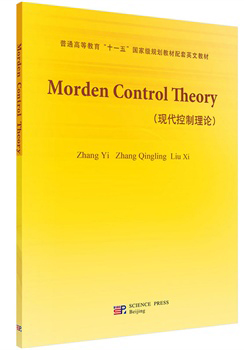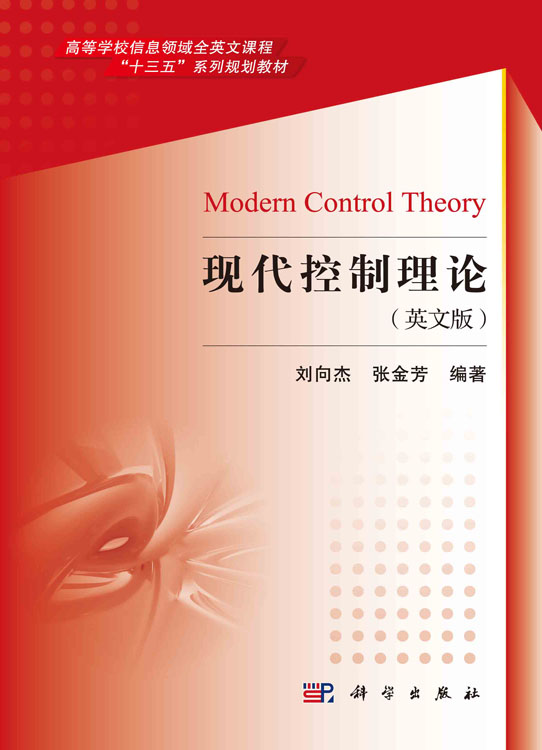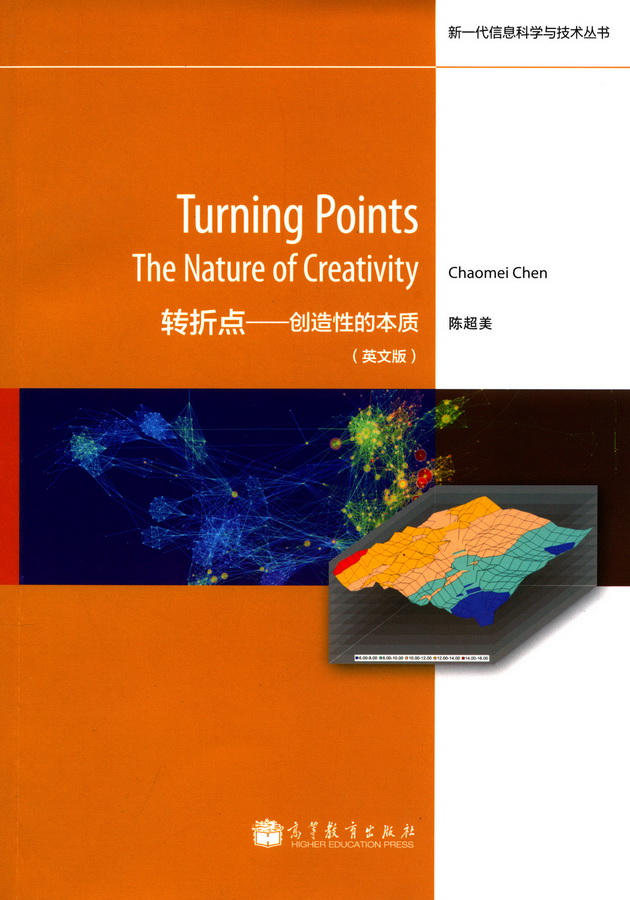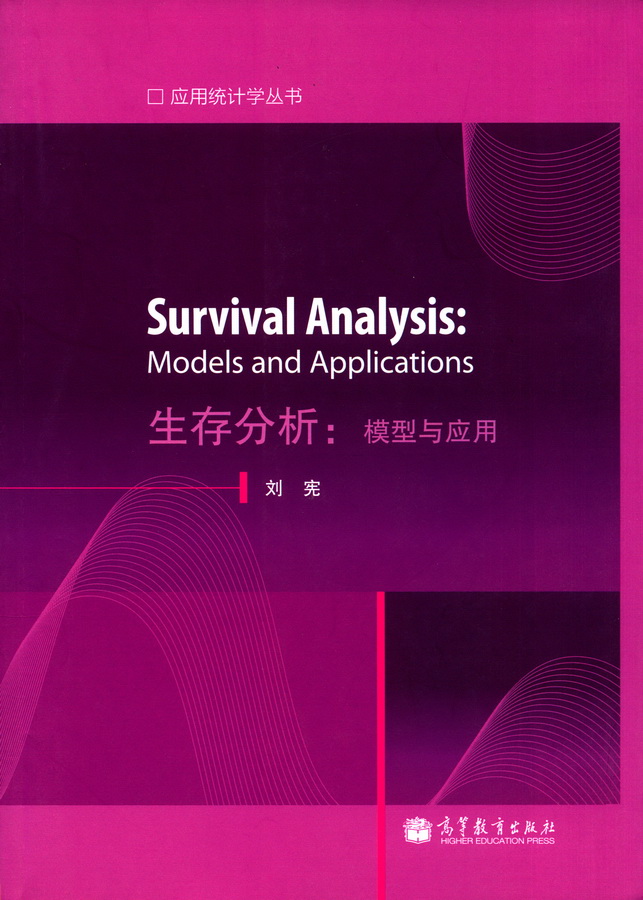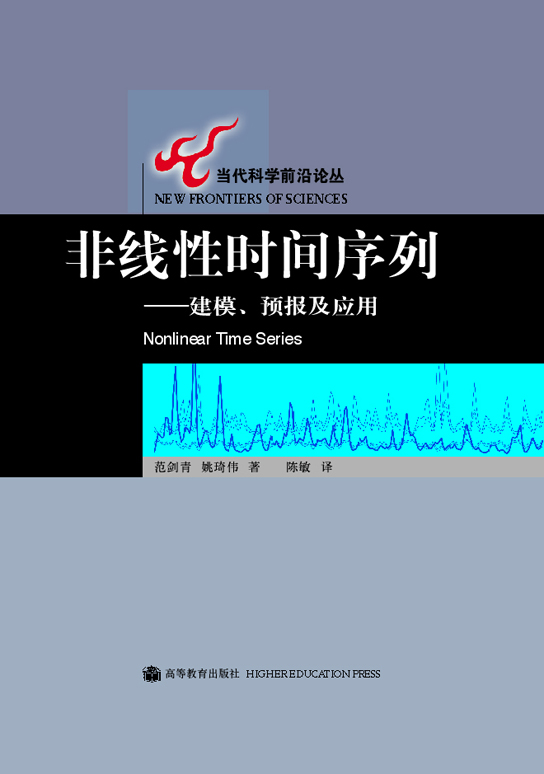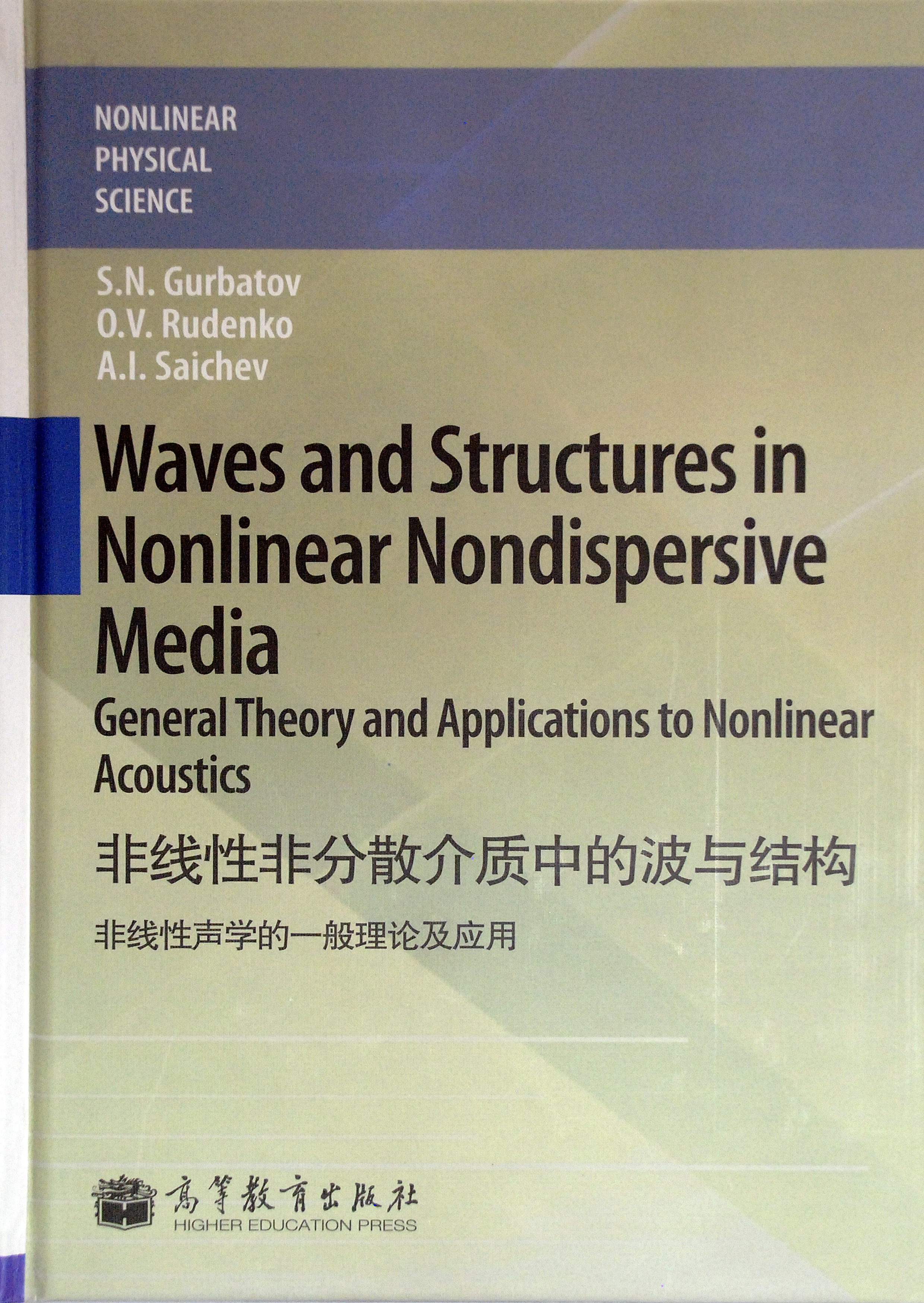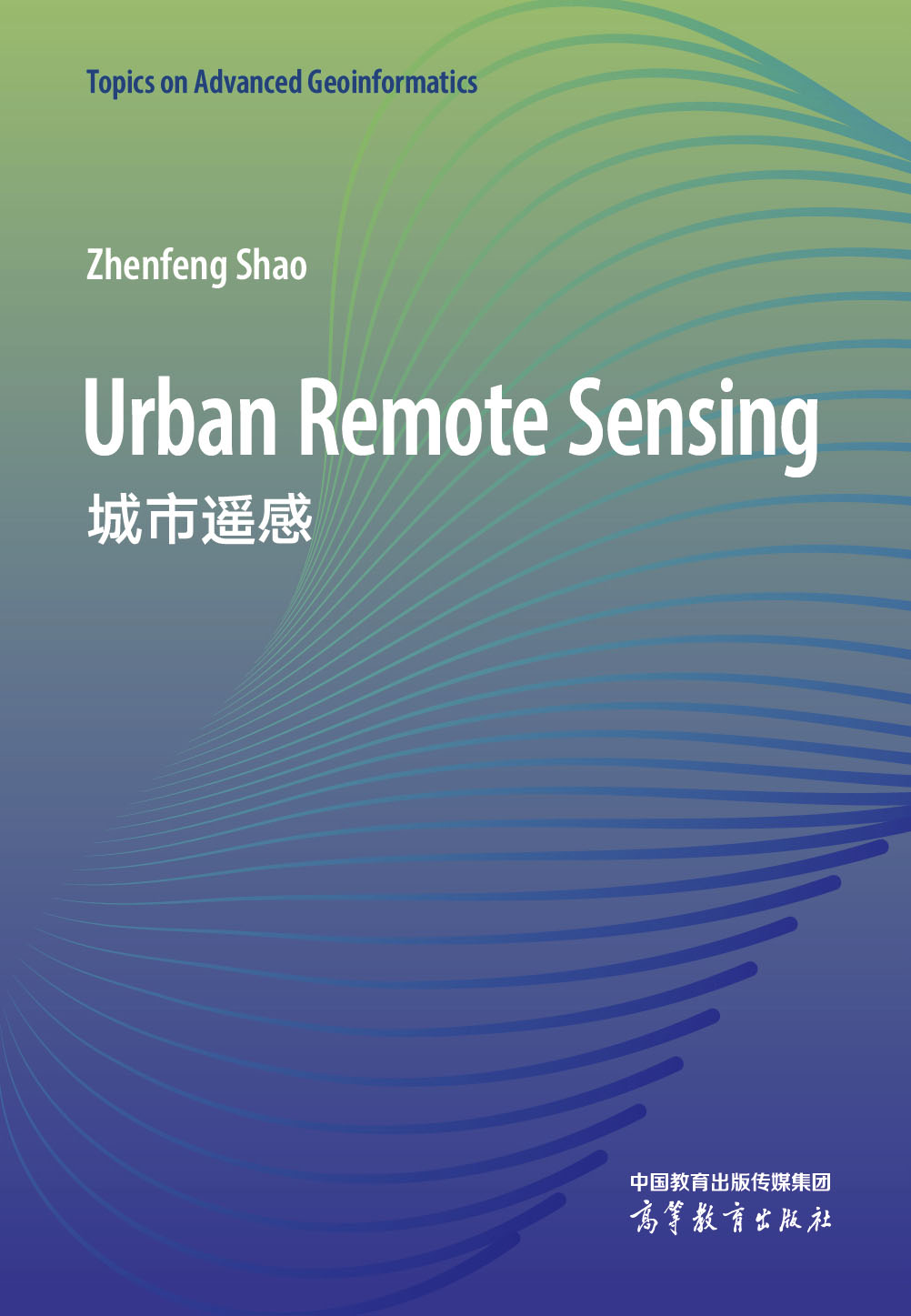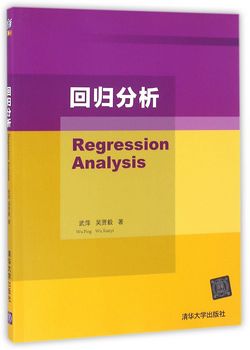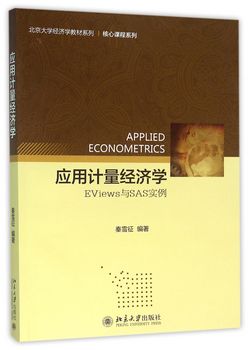Modern Control Theory
¥38.00定价
作者: 张翼
出版时间:2014-07
出版社:科学出版社
- 科学出版社
- 9787030412522
- 1-1
- 151119
- 47150727-7
- 平装
- 2014-07
- 234
- 188
- 工学
- 控制科学与工程
- O231
- 数学
内容简介
建立在状态空间法基础上的一种控制理论,是自动控制理论的一个主要组成部分。在现代控制理论中,对控制系统的分析和设计主要是通过对系统的状态变量的描述来进行的,基本的方法是时间域方法。现代控制理论比经典控制理论所能处理的控制问题要广泛得多,包括线性系统和非线性系统,定常系统和时变系统,单变量系统和多变量系统。它所采用的方法和算法也更适合于在数字计算机上进行。现代控制理论还为设计和构造具有指定的性能指标的最优控制系统提供了可能性。
这本由Zhang Yi、Zhang Qingling、Liu Xi编写的《现代控制理论(普通高等教育十一五国家级规划教材配套英文教材)》是关于介绍“现代控制理论”的英文版教材。
这本由Zhang Yi、Zhang Qingling、Liu Xi编写的《现代控制理论(普通高等教育十一五国家级规划教材配套英文教材)》是关于介绍“现代控制理论”的英文版教材。
目录
Preface
Chapter 0 Backgrounds
0.1 Development of Control Theory
0.2 Main Contents of Modern Control Theory
Chapter 1 Mathematical Description of Systems
1.1 Example
1.2 Basic Definitions
1.3 System Descriptions
1.4 Finding State Equations from High-Differential Operator Representation
1.4.1 Controllable Canonical Form
1.4.2 Observable Canonical Form
1.4.3 Other Special Form
1.5 Block Diagram
1.6 Transfer Function from State Space Representation
1.6.1 Definition
1.6.2 Calculation for the Transfer Function Matrix
1.7 Composite Systems
1.7.1 Tandem Connection
1.7.2 Parallel Connection
1.7.3 Feedback Connection
1.8 Equivalent Transformation
1.8.1 Equivalent Transformation of the State Space Description for Linear Systems
1.8.2 Diagonal Canonical Form and Jordan Canonical Form of the System
1.8.3 Invarianee of the System Matrix and Transfer Function Matrix
1.9 Application of MATLAB in the Representation of Linear Systems
1.10 Exercises
Chapter 2 Solutions
2.1 State Transition Matrix
2.2 Matrix Exponential
2.2.1 Definition
2.2.2 Properties of the Matrix Exponential
2.2.3 Calculations for the Matrix Exponential
2.3 Solution of Linear Time-Invariant Systems
2.4 Solution of Linear Time-Varying Systems
2.5 Linear Discrete Time-Invariant Systems
2.5.1 Discretization of Linear Discrete Time-Invariant Systems "
2.5.2 Solutions of the Linear Discrete Time-Invariant Systems
2.6 MATLAB for Linear System Motion Analysis
2.7 Exercises
Chapter 3 Controllability and Observability
3.1 Definitions
3.1.1 Controllability
3.1.2 Observability
3.2 Controllability of Linear Continuous Systems
3.2.1 Time-Invariant Systems
3.2.2 Time-Varying Systems
3.2.3 Controllability Index
3.3 Observability of Linear Continuous Systems
3.3.1 Time-Invariant Systems
3.3.2 Time-Varying Systems
3.3.3 Observability Index
3.4 Principle of Duality
3.5 Controllable and Observable Canonical Forms of SISO
3.6 Structural Decomposition of Linear Systems
3.6.1 Controllability and Observability of Linear Time-Invariant Systems with Nonsingular Transformation
3.6.2 Controllability Decomposition
3.6.3 Observable Decomposition
3.6.4 Canonical Decomposition
3.7 MATLAB Application for Controllability and Observability
3.8 Exercises
Chapter 4 Irreducible Realizations
4.1 Introduction
4.2 The Realization of Transfer Function Matrix of SISO Control Systems..
4.3 The Realization of Transfer Function Matrix of MIMO Control Systems
4.4 The Minimal Realization
4.5 Irreducible Realization by MATLAB
4.6 Exercises
Chapter 5 Stability
5.1 Definitions
5.2 Stability Criteria
5.2.1 Routh Criterion
5.2.2 Root Locus Method
5.2.3 The First Method of Lyapunov
5.2.4 The Second Method of Lyapunov
5.2.5 Krasovsky Discriminance
5.2.6 Variable Gradient Method
5.3 Application of MATLAB in Stability
5.4 Exercises
Chapter 6 Feedbacks
6.1 Definitions
6.1.1 State Feedbacks
6.1.2 Output Feedbacks
6.1.3 Derivative Feedback
6.2 The Effects of Controllability and Observability by Feedback
6.2.1 State Feedbacks
6.2.2 Output Feedbacks
6.3 Pole Assignment
6..3.1 SISO Case
6.3.2 MIMO Case
6.4 Stabilization
6.5 Decoupling
6.5.1 The Statement of Decoupling Control Problem
6.5.2 Necessary and Sufficient Conditions for Decoupling Systems with the State Feedback
6.6 Application of MATLAB in Feedback
6.6.1 State Feedback and Pole Assignment by MATLAB
6.6.2 Decoupling by MATLAB
6.7 Exercises
Chapter 7 Observers
7.1 Basic Concepts
7.2 Dimensional State Observers
7.3 Reduced-Dimensional State Observers
7.4 Feedback System with State Observers
7.5 Design Stat
Chapter 0 Backgrounds
0.1 Development of Control Theory
0.2 Main Contents of Modern Control Theory
Chapter 1 Mathematical Description of Systems
1.1 Example
1.2 Basic Definitions
1.3 System Descriptions
1.4 Finding State Equations from High-Differential Operator Representation
1.4.1 Controllable Canonical Form
1.4.2 Observable Canonical Form
1.4.3 Other Special Form
1.5 Block Diagram
1.6 Transfer Function from State Space Representation
1.6.1 Definition
1.6.2 Calculation for the Transfer Function Matrix
1.7 Composite Systems
1.7.1 Tandem Connection
1.7.2 Parallel Connection
1.7.3 Feedback Connection
1.8 Equivalent Transformation
1.8.1 Equivalent Transformation of the State Space Description for Linear Systems
1.8.2 Diagonal Canonical Form and Jordan Canonical Form of the System
1.8.3 Invarianee of the System Matrix and Transfer Function Matrix
1.9 Application of MATLAB in the Representation of Linear Systems
1.10 Exercises
Chapter 2 Solutions
2.1 State Transition Matrix
2.2 Matrix Exponential
2.2.1 Definition
2.2.2 Properties of the Matrix Exponential
2.2.3 Calculations for the Matrix Exponential
2.3 Solution of Linear Time-Invariant Systems
2.4 Solution of Linear Time-Varying Systems
2.5 Linear Discrete Time-Invariant Systems
2.5.1 Discretization of Linear Discrete Time-Invariant Systems "
2.5.2 Solutions of the Linear Discrete Time-Invariant Systems
2.6 MATLAB for Linear System Motion Analysis
2.7 Exercises
Chapter 3 Controllability and Observability
3.1 Definitions
3.1.1 Controllability
3.1.2 Observability
3.2 Controllability of Linear Continuous Systems
3.2.1 Time-Invariant Systems
3.2.2 Time-Varying Systems
3.2.3 Controllability Index
3.3 Observability of Linear Continuous Systems
3.3.1 Time-Invariant Systems
3.3.2 Time-Varying Systems
3.3.3 Observability Index
3.4 Principle of Duality
3.5 Controllable and Observable Canonical Forms of SISO
3.6 Structural Decomposition of Linear Systems
3.6.1 Controllability and Observability of Linear Time-Invariant Systems with Nonsingular Transformation
3.6.2 Controllability Decomposition
3.6.3 Observable Decomposition
3.6.4 Canonical Decomposition
3.7 MATLAB Application for Controllability and Observability
3.8 Exercises
Chapter 4 Irreducible Realizations
4.1 Introduction
4.2 The Realization of Transfer Function Matrix of SISO Control Systems..
4.3 The Realization of Transfer Function Matrix of MIMO Control Systems
4.4 The Minimal Realization
4.5 Irreducible Realization by MATLAB
4.6 Exercises
Chapter 5 Stability
5.1 Definitions
5.2 Stability Criteria
5.2.1 Routh Criterion
5.2.2 Root Locus Method
5.2.3 The First Method of Lyapunov
5.2.4 The Second Method of Lyapunov
5.2.5 Krasovsky Discriminance
5.2.6 Variable Gradient Method
5.3 Application of MATLAB in Stability
5.4 Exercises
Chapter 6 Feedbacks
6.1 Definitions
6.1.1 State Feedbacks
6.1.2 Output Feedbacks
6.1.3 Derivative Feedback
6.2 The Effects of Controllability and Observability by Feedback
6.2.1 State Feedbacks
6.2.2 Output Feedbacks
6.3 Pole Assignment
6..3.1 SISO Case
6.3.2 MIMO Case
6.4 Stabilization
6.5 Decoupling
6.5.1 The Statement of Decoupling Control Problem
6.5.2 Necessary and Sufficient Conditions for Decoupling Systems with the State Feedback
6.6 Application of MATLAB in Feedback
6.6.1 State Feedback and Pole Assignment by MATLAB
6.6.2 Decoupling by MATLAB
6.7 Exercises
Chapter 7 Observers
7.1 Basic Concepts
7.2 Dimensional State Observers
7.3 Reduced-Dimensional State Observers
7.4 Feedback System with State Observers
7.5 Design Stat

